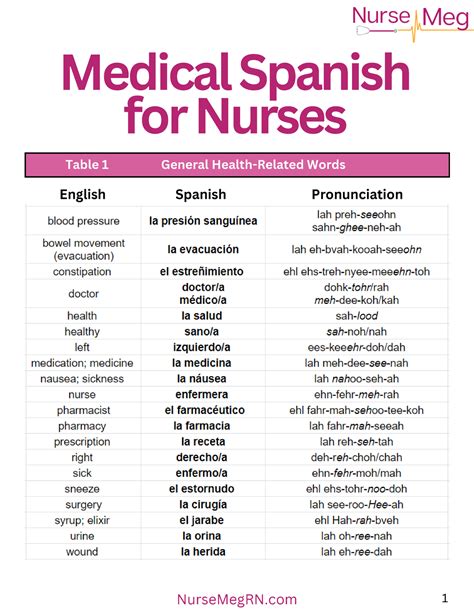Intro
Master medical terminology in Spanish with our comprehensive guide. Learn essential medical terms in Spanish, including anatomy, diagnosis, and treatment vocabulary. Improve patient communication and cultural competence with our list of common medical phrases and terminology. Perfect for healthcare professionals, medical students, and Spanish learners.
Learning medical terms in Spanish can be a valuable skill for healthcare professionals, medical students, and anyone interested in communicating effectively with Spanish-speaking patients. With over 460 million native Spanish speakers worldwide, it's essential to bridge the language gap in medical communication.

In this article, we'll explore the importance of medical Spanish, provide a comprehensive list of common medical terms, and offer tips for learning and practicing medical Spanish.
Why Learn Medical Spanish?
Effective communication is crucial in healthcare, and language barriers can lead to misunderstandings, misdiagnoses, and inadequate treatment. By learning medical Spanish, healthcare professionals can:
- Improve patient care and outcomes
- Enhance patient satisfaction and trust
- Reduce medical errors and miscommunication
- Increase cultural competency and awareness
- Expand career opportunities in the healthcare industry
Benefits of Learning Medical Spanish
- Better patient communication: Medical Spanish enables healthcare professionals to communicate effectively with Spanish-speaking patients, understand their concerns, and provide accurate diagnoses and treatment plans.
- Improved patient safety: Clear communication reduces the risk of medical errors, misdiagnoses, and adverse reactions.
- Enhanced patient satisfaction: Patients feel more comfortable and confident when healthcare professionals can communicate with them in their native language.
- Increased job opportunities: Knowing medical Spanish can give healthcare professionals a competitive edge in the job market and open up opportunities to work with diverse patient populations.
Common Medical Terms in Spanish
Here are some common medical terms in Spanish, organized by category:
Anatomy and Body Parts
- Cabeza (head)
- Ojos (eyes)
- Orejas (ears)
- Nariz (nose)
- Boca (mouth)
- Cuello (neck)
- Espalda (back)
- Pecho (chest)
- Abdomen (abdomen)
- Piernas (legs)
- Brazos (arms)
Medical Conditions and Symptoms
- Dolor (pain)
- Fiebre (fever)
- Tos (cough)
- Fatiga (fatigue)
- Náuseas (nausea)
- Vómitos (vomiting)
- Diarrea (diarrhea)
- Constipación (constipation)
- Asma (asthma)
- Diabetes (diabetes)
Medical Procedures and Treatments
- Examen físico (physical exam)
- Análisis de sangre (blood test)
- Radiografía (x-ray)
- Ultrasonido (ultrasound)
- Cirugía (surgery)
- Medicación (medication)
- Inyección (injection)
- Vacuna (vaccine)
Medical Specialties
- Cardiología (cardiology)
- Dermatología (dermatology)
- Gastroenterología (gastroenterology)
- Nefrología (nephrology)
- Neurología (neurology)
- Obstetricia y ginecología (obstetrics and gynecology)
- Oftalmología (ophthalmology)
- Ortopedia (orthopedics)
Tips for Learning Medical Spanish
- Start with basic Spanish language skills: Focus on grammar, vocabulary, and pronunciation.
- Use online resources: Websites, apps, and online courses can provide interactive and engaging learning experiences.
- Practice with native speakers: Engage in conversations with native Spanish speakers to improve your speaking and listening skills.
- Focus on medical terminology: Learn common medical terms and phrases, and practice using them in context.
- Immerse yourself in the language: Watch Spanish-language medical videos, listen to podcasts, and read Spanish-language medical texts.
Resources for Learning Medical Spanish
- Online courses:
- Coursera: Medical Spanish Specialization
- edX: Medical Spanish
- Medical Spanish Institute: Online Courses
- Apps:
- Medical Spanish (iOS and Android)
- SpanishDict (iOS and Android)
- Memrise (iOS and Android)
- Websites:
- Medical Spanish Institute: Resources and Tips
- SpanishDict: Medical Spanish Dictionary
- MedlinePlus: Spanish-language health information
Conclusion
Learning medical Spanish can significantly improve communication with Spanish-speaking patients, enhance patient care, and increase career opportunities in the healthcare industry. By starting with basic language skills, practicing with native speakers, and focusing on medical terminology, healthcare professionals can become proficient in medical Spanish. Utilize online resources, apps, and websites to support your learning journey.
Why is medical Spanish important in healthcare?
+Medical Spanish is essential in healthcare because it enables healthcare professionals to communicate effectively with Spanish-speaking patients, improving patient care, safety, and satisfaction.
How can I learn medical Spanish?
+You can learn medical Spanish through online courses, apps, and websites, as well as by practicing with native speakers and immersing yourself in the language.
What are some common medical terms in Spanish?
+Common medical terms in Spanish include "dolor" (pain), "fiebre" (fever), "tos" (cough), and "asma" (asthma), as well as medical procedures like "examen físico" (physical exam) and "análisis de sangre" (blood test).
